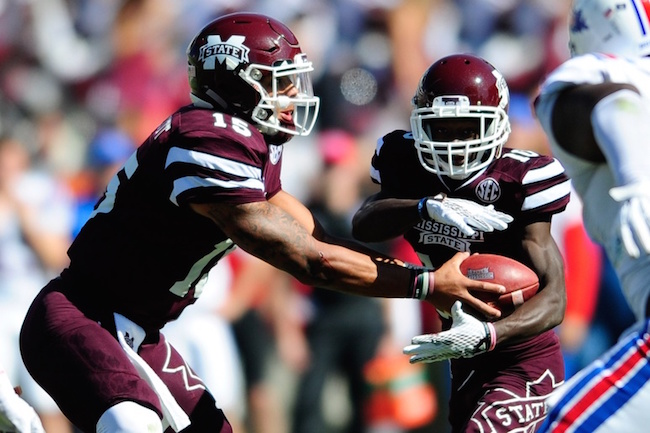
Where has Mississippi State's backfield been in 2015?
Last season, Mississippi State was one of the best rushing offenses in college football. This year, not so much.
In 2014, the Bulldogs rushed for 3,030 yards, good for 21st in the country. Mississippi State’s 233.1 rushing yards per game, 5.2 yards per carry, and 578 rushing attempts all ranked 23rd in the FBS and its 29 rushing touchdowns was tied for 34th.
Sure, the Bulldogs lost Josh Robinson from last year’s backfield, but how could the loss of that one player totally flip the script for Mississippi State’s rushing attack?
This season, the Bulldogs have moved away from a run-heavy attack and have plummeted in the rushing rankings nationally. Through 11 games, the Bulldogs rank 116th in rushing attempts with 358. Their 1,536 yards on the ground rank 102nd in the nation and they are tied for 82nd in the FBS in rushing TDs (17) and are 73rd in yards per carry (4.3). Mississippi State’s 139.6 rushing yards per game is 101st in college football.
Those numbers start to make sense when you realize that QB Dak Prescott is the leading rusher with 478 rushing yards this season. It has been a backfield by committee in Starkville this season, but the lack of a standout running back has hindered the Bulldogs run game.
Last season, Robinson was 10th in the SEC in rushing attempts (190) and finished third in the conference in rushing yards (1,203). He also added 11 rushing TDs. With opponents forced to stop Robinson, Prescott was more effective as a runner in 2014.
Prescott served as the Bulldogs’ second running back in his junior season and rushed 210 times for 986 yards and 14 rushing TDs.
This season, Mississippi State’s running backs have not combined for Robinson’s production. Besides Prescott, the 11 Mississippi State ballcarriers this season have combined for 1,058 yards and eight TDs.
A change in philosophy for also led to the decline of the run game.
The Bulldogs went from a run-oriented team a year ago to one that’s content with Prescott throwing to beat teams.
Mississippi State’s offense finished last season with 155 more rushing attempts than it had passes thrown. With two games remaining this season, the Bulldogs have thrown 58 times more than they’ve run.
It’s most likely a combination of several factors — a dip in talent, a change in offensive philosophy, changes along the offensive line, etc. — but Mississippi State has transitioned in one year from a running team to a passing one.
